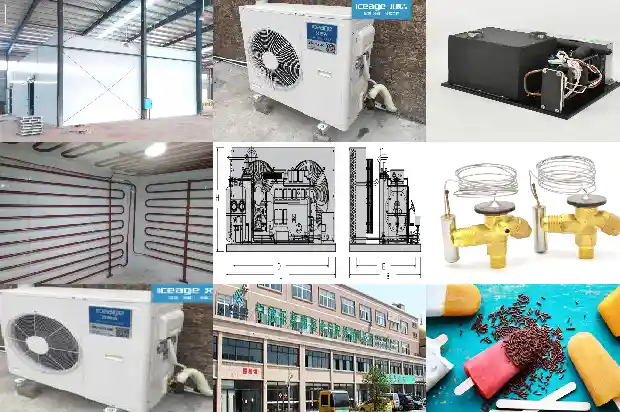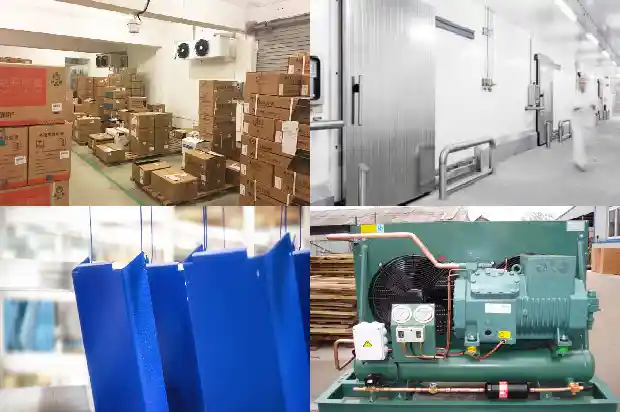Pipelines Used in the Refrigeration System
2025-03-02
According to the regulations on pressure pipelines in the "Safety Technical Regulations for Pressure Pipelines": "The maximum working pressure is greater than or equal to 0.1MPa; the nominal diameter is greater than 25mm; the conveyed medium is gas, steam, liquefied gas, a liquid with a maximum working temperature higher than or equal to its standard boiling point, or a flammable, explosive, toxic, or corrosive liquid." Some pipelines in the refrigeration system fall within the scope of pressure pipelines, so strict attention should be paid to the selection of pipelines in the refrigeration system.
I. Pipeline Material Selection
There are copper pipes, seamless steel pipes, and stainless steel seamless pipes. (Copper pipes cannot be used in systems with ammonia refrigerant.)
(1) Copper Pipes
There are red copper pipes (industrial pure copper) and brass pipes (copper-zinc alloy). According to different manufacturing methods, they are divided into drawn pipes, rolled pipes, and extruded pipes. Generally, drawn pipes are used for medium and low-pressure pipelines. Red copper pipes are more commonly used in refrigeration units using Freon refrigerant, with the grade TP2. The outer diameter specifications (mm) are 10, 12, 16, 22, 28, 35, 42, and 54. The fixed length is generally 4 meters per piece. To facilitate bending, the copper pipe with a diameter of φ6*1 is in a semi-hard state H55 (Y2), and the others with different diameters are generally in a soft state o60 (M). (Copper pipes used in refrigerators will have special markings by the manufacturer.) The chemical composition, dimensional deviation, straightness, roundness, mechanical properties, and technological properties of the copper pipe materials shall comply with the requirements of GB/T17791 - 2017 "Seamless Copper and Copper Alloy Tubes for Air Conditioning and Refrigeration Equipment".
(2) Seamless Steel Pipes
There are 10# (for working conditions below - 29°C) and 20# (for working conditions below - 20°C, the most commonly used in cold storage refrigeration systems) carbon steel seamless steel pipes, which need to comply with the provisions of GB8163.
16Mn low-alloy steel pipes are generally applied to the pipeline materials of carbon dioxide refrigeration systems and ultra-low-temperature cold storage refrigeration systems. Some refrigeration units use stainless steel pipes as exhaust pipelines, which need to comply with the provisions of GB14976.
II. Determination of Pipe Diameter and Cleaning before Installation
The pipe diameter can be calculated based on the refrigerant flow rate in the pipe and the total pressure loss of the pipeline. The calculation is based on ensuring the minimum refrigerant pressure drop and the minimum refrigerant flow rate for effective oil return.
To prevent debris from entering the refrigeration system, causing damage to the refrigeration unit or blocking the pipelines, valves, filters, etc., the pipelines should be inspected and cleaned before processing and when configured into the refrigeration system. For pipelines that are not in use temporarily, the two ends must be blocked to prevent debris from entering.
The welding of copper pipes adopts nitrogen-shielded welding to prevent the generation of oxide scales. Since seamless steel pipes are prone to rust, the pipes should be cleaned before fabrication, and the oxide scales, dirt, and rust on the inner and outer walls should be removed until the metal luster appears on the pipe wall surface.
III. Installation Requirements
I. Pipeline Material Selection
There are copper pipes, seamless steel pipes, and stainless steel seamless pipes. (Copper pipes cannot be used in systems with ammonia refrigerant.)
(1) Copper Pipes
There are red copper pipes (industrial pure copper) and brass pipes (copper-zinc alloy). According to different manufacturing methods, they are divided into drawn pipes, rolled pipes, and extruded pipes. Generally, drawn pipes are used for medium and low-pressure pipelines. Red copper pipes are more commonly used in refrigeration units using Freon refrigerant, with the grade TP2. The outer diameter specifications (mm) are 10, 12, 16, 22, 28, 35, 42, and 54. The fixed length is generally 4 meters per piece. To facilitate bending, the copper pipe with a diameter of φ6*1 is in a semi-hard state H55 (Y2), and the others with different diameters are generally in a soft state o60 (M). (Copper pipes used in refrigerators will have special markings by the manufacturer.) The chemical composition, dimensional deviation, straightness, roundness, mechanical properties, and technological properties of the copper pipe materials shall comply with the requirements of GB/T17791 - 2017 "Seamless Copper and Copper Alloy Tubes for Air Conditioning and Refrigeration Equipment".
(2) Seamless Steel Pipes
There are 10# (for working conditions below - 29°C) and 20# (for working conditions below - 20°C, the most commonly used in cold storage refrigeration systems) carbon steel seamless steel pipes, which need to comply with the provisions of GB8163.

16Mn low-alloy steel pipes are generally applied to the pipeline materials of carbon dioxide refrigeration systems and ultra-low-temperature cold storage refrigeration systems. Some refrigeration units use stainless steel pipes as exhaust pipelines, which need to comply with the provisions of GB14976.
II. Determination of Pipe Diameter and Cleaning before Installation
The pipe diameter can be calculated based on the refrigerant flow rate in the pipe and the total pressure loss of the pipeline. The calculation is based on ensuring the minimum refrigerant pressure drop and the minimum refrigerant flow rate for effective oil return.
To prevent debris from entering the refrigeration system, causing damage to the refrigeration unit or blocking the pipelines, valves, filters, etc., the pipelines should be inspected and cleaned before processing and when configured into the refrigeration system. For pipelines that are not in use temporarily, the two ends must be blocked to prevent debris from entering.
The welding of copper pipes adopts nitrogen-shielded welding to prevent the generation of oxide scales. Since seamless steel pipes are prone to rust, the pipes should be cleaned before fabrication, and the oxide scales, dirt, and rust on the inner and outer walls should be removed until the metal luster appears on the pipe wall surface.

III. Installation Requirements
- When the refrigeration pipeline passes through the wall or floor slab, a steel casing should be installed outside it, and the pipeline weld seam should not be placed inside the casing. The gap between the casing and the pipeline should be tightly filled with thermal insulation materials to prevent condensation.
- The connection methods of refrigeration pipelines include welding connection, threaded connection, and flange connection. When using welding connection, pay attention to selecting appropriate solder when connecting different materials (such as connecting copper pipes and iron pipes, connecting copper pipes and stainless steel pipes, etc.). For pipelines with a diameter less than 32mm, threaded connection can be used. Before connection, remove the impurities on the threads and wind polytetrafluoroethylene raw material tape as the threaded sealing filler. For parts that are often disassembled and overhauled, flange connection is generally used. The flange should have a male-female sealing surface, and the flange gasket should use a 2∽3mm medium-pressure oil-resistant rubber asbestos plate to enhance the seal. When connecting pipelines with different diameters, reducing (concentric reducing pipe) fittings should be used for connection.
- The installation of the horizontal suction pipe should have a slope towards the unit so that the lubricating oil can smoothly return to the compressor by gravity; oil return bends and double vertical pipes should be used for the vertical section of the pipeline; the suction pipeline should have thermal insulation measures. The exhaust pipe should have a slope towards the oil separator.
The refrigeration system is a sealed system jointly composed of refrigeration equipment and refrigeration pipelines. After the installation is completed, the entire system should be cleaned of dirt to remove the impurities in the system. When cleaning the system, use 0.6∽0.8MPa compressed air in sections. Before cleaning, the instruments and safety valves should be protected, and the valve cores of the solenoid valves and check valves and the filter screens should be removed.
Related Articles
- Does a lower evaporation temperature result in a larger refrigeration capacity, or does a higher evaporation temperature lead to a larger refrigeration capacity?
- Energy - saving Control and Adjustment of Main Operating Parameters of the Refrigeration System
- HVAC - Concise Explanation of Refrigeration Principles
- Analysis of Common Auxiliary Components in the Refrigeration System One by One
- A Detailed Analysis of the Nine Reasons for the Low Pressure in the Refrigeration System!
- These Inspections before Starting the Refrigeration Unit Are Very Important~~
- Common Fault Causes of Totally Enclosed Refrigeration Compressors
- Popularize Refrigeration Knowledge You've Never Noticed, Which Is Actually Very Crucial
- Analysis of Common Auxiliary Components in the Refrigeration System
- Does the Refrigeration System Definitely Need to Be Evacuated? What Will Happen If It Isn't?
- Common Faults in Refrigeration Systems and Handling Methods
- Why Should Refrigeration Shut - off Valves Have "Low - Inlet and High - Outlet" Design?
- Four Requirements for Refrigeration Systems Adopting Two - stage Compression Refrigeration Systems
- Screw Compressor Units: Principles, Design and Selection - Essential Guide for Refrigeration Beginners
- Don't Overlook: The Impact of Capillary Tube Length on Refrigeration System Parameters
- Refrigeration Repair Techniques: A Must - Know - "Sub - cooling" and "Super - heating"
- What Impact Does Pressure Have on the Refrigeration System?
- Advanced Guide! Design and Installation of Refrigeration System Pipelines
